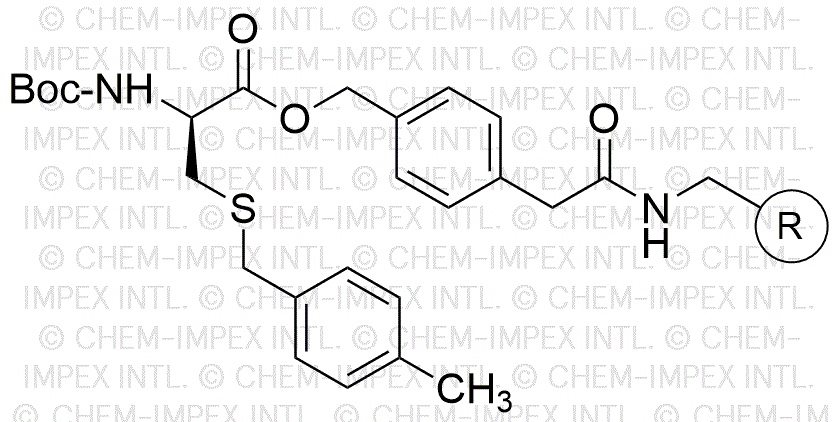|
Boc-S-4-methylbenzyl-D-cysteine 4-oxymethylphenylacetamidomethyl is widely utilized in research focused on:
- Peptide Synthesis: This compound serves as a protecting group in the synthesis of peptides, allowing for the selective modification of amino acids without affecting others. This is crucial in developing complex peptide-based drugs.
- Drug Development: Its unique structure can be used to create novel pharmaceutical compounds, particularly in designing targeted therapies for diseases such as cancer, where precision is key.
- Bioconjugation: The chemical is employed in bioconjugation techniques, linking biomolecules to enhance drug delivery systems or create targeted imaging agents, improving the efficacy of treatments.
- Research in Neuroscience: It can be used to study neuroprotective effects and the role of specific amino acids in neurological disorders, providing insights that can lead to new therapeutic strategies.
- Cosmetic Formulations: The compound's properties make it suitable for use in cosmetic products aimed at skin repair and rejuvenation, appealing to the growing market for effective skincare solutions.
General Information
Properties
Safety and Regulations
Applications
Boc-S-4-methylbenzyl-D-cysteine 4-oxymethylphenylacetamidomethyl is widely utilized in research focused on:
- Peptide Synthesis: This compound serves as a protecting group in the synthesis of peptides, allowing for the selective modification of amino acids without affecting others. This is crucial in developing complex peptide-based drugs.
- Drug Development: Its unique structure can be used to create novel pharmaceutical compounds, particularly in designing targeted therapies for diseases such as cancer, where precision is key.
- Bioconjugation: The chemical is employed in bioconjugation techniques, linking biomolecules to enhance drug delivery systems or create targeted imaging agents, improving the efficacy of treatments.
- Research in Neuroscience: It can be used to study neuroprotective effects and the role of specific amino acids in neurological disorders, providing insights that can lead to new therapeutic strategies.
- Cosmetic Formulations: The compound's properties make it suitable for use in cosmetic products aimed at skin repair and rejuvenation, appealing to the growing market for effective skincare solutions.
Documents
Safety Data Sheets (SDS)
The SDS provides comprehensive safety information on handling, storage, and disposal of the product.
Product Specification (PS)
The PS provides a comprehensive breakdown of the product’s properties, including chemical composition, physical state, purity, and storage requirements. It also details acceptable quality ranges and the product's intended applications.
Certificates of Analysis (COA)
Search for Certificates of Analysis (COA) by entering the products Lot Number. Lot and Batch Numbers can be found on a product’s label following the words ‘Lot’ or ‘Batch’.
Numéro de catalogue
Numéro de lot/série
Certificates Of Origin (COO)
This COO confirms the country where the product was manufactured, and also details the materials and components used in it and whether it is derived from natural, synthetic, or other specific sources. This certificate may be required for customs, trade, and regulatory compliance.
Numéro de catalogue
Numéro de lot/série
Safety Data Sheets (SDS)
The SDS provides comprehensive safety information on handling, storage, and disposal of the product.
DownloadProduct Specification (PS)
The PS provides a comprehensive breakdown of the product’s properties, including chemical composition, physical state, purity, and storage requirements. It also details acceptable quality ranges and the product's intended applications.
DownloadCertificates of Analysis (COA)
Search for Certificates of Analysis (COA) by entering the products Lot Number. Lot and Batch Numbers can be found on a product’s label following the words ‘Lot’ or ‘Batch’.
Numéro de catalogue
Numéro de lot/série
Certificates Of Origin (COO)
This COO confirms the country where the product was manufactured, and also details the materials and components used in it and whether it is derived from natural, synthetic, or other specific sources. This certificate may be required for customs, trade, and regulatory compliance.


